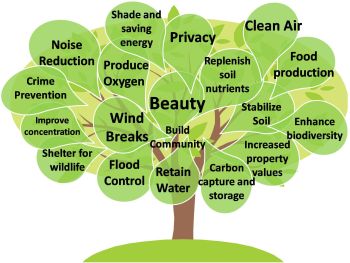Posted by Tree In A Box on 1st Nov 2017
What is a Tree Worth?

Many people quantify the worth of a tree by calculating how much lumber it will produce, how much paper it will make, or how warm it will keep us when we burn it. While others think outside of that wooden box when it comes to the value of trees.
No matter which way you think about trees, we can all agree that trees do more for us than we do for them. The most important thing that trees do for our planet is the removal of carbon from the air. Trees store the carbon and in exchange give us oxygen.
These past few months the Paris Climate Accord has made the news quite a bit. Whether you were for it or against it, there is no denying that forest protection should be high on the priority list. Protecting our forests is extremely important considering how good our forests are at removing and storing carbon.
The question is how can we keep as much forest as possible and still drive economy and growth?
This idea started based on the idea of how the carbon market might actually act as a tool to protect our forests. Their idea was fairly straight forward, if landowners could generate revenue by leaving trees standing and taking advantage of the carbon benefits, they may be more apt to choose conservation approaches to land rather than clear-cut destructive practices.
Who did the research and came to the conclusion of using carbon benefits? If you are thinking it was some educational institution, you would be wrong. The conceptual experiment was born through the collaboration of the Dogwood Alliance, Staples, Domtar, Home Depot, Columbia Forest Products, Forestland Group, Pacific Forest Trust, EcoForesters and many more companies and organizations. As you can see some heavy hitters came together to test their theory through a pilot project. This experiment provided quite a bit of learning, including how to quantify the carbon value of forests, how to navigate the technical complexities of forest carbon standards, how to access forest carbon markets and how to bring all this knowledge together to create scaled projects that can make a real difference in climate change.
What did they learn through the Carbon Canopy Project?
- The value of forest carbon is not fully recognized by government policies or markets
- Costs for doing carbon projects are prohibitive for most landowners
- Landowners need technical support for project development
- Other programs outside the current offset model need to be developed
- There is great power in non-traditional collaborations and experimentation
- Landowners don’t get carbon credits by clearcutting forests; they get them by leaving more trees in the ground
This project also spurred on the launch of the Wetlands Forest Initiative (http://wetlandforests.org/) to conserve, restore, and improve Southern wetland forests to strengthen our communities through science-based actions, diverse partnerships, and citizen and landowner engagement.
This is a start and there is more to do, we can all make a difference if we try. Why not take the opportunity to help and start your own urban forest with Tree In A Box tree kits.

